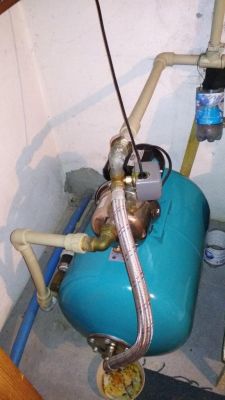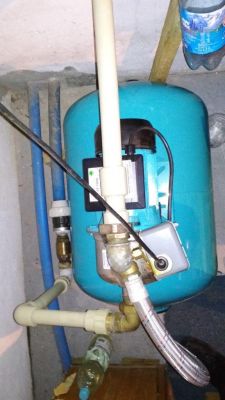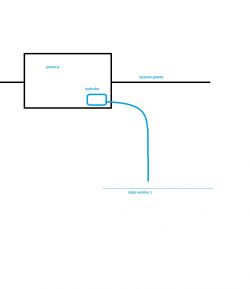I have an omnigena 100 L hydrophore with a JY1000 pump, mounted with a deep well, the water surface is probably about 8-10 m below the basement floor with the hydrophore. The water is quite irony, but the system lasts about 2-3 years.
Well about 2-3 meters from the hydrophore. Outer diameter blue pipe on the suction about 4-6 cm, I will check again. There is a check valve in front of the hydrophore.
After unscrewing the flange in the tank you can see quite a lot of gray / brown sludge. Some time ago I had to replace the knee "at the outlet" just above the pump because the iron deposited blocked the light of the internal section in about 50-60%.
Does a possible sand filter make sense or is it better to add iron remover?
Can be mounted directly on the blue feed pipes and possibly where is the best? Do I need to fix the cabinets to the wall?
Or maybe not add a filter at all? From what I have checked it is for a single body
https://www.ustm.pl/produkty/filtry-do-wody/korpusy-narurowe/korpusy-wfw-emi/
and the contribution of e.g. 10 "
https://www.ustm.pl/produkty/filtry-do-wody/wklady/wklady-odzelaziajace---ir/
the flow will be very limited, to 5 L / min
in turn, larger housings and inserts cost several hundred PLN.
Typical sand filters have a black housing, so if I would like to buy a transparent one, so that I can assess the degree of contamination without disassembling ... great designers forgot about it :)
The water is used to fill the toilet flush and water the garden.
Thank you in advance !



Well about 2-3 meters from the hydrophore. Outer diameter blue pipe on the suction about 4-6 cm, I will check again. There is a check valve in front of the hydrophore.
After unscrewing the flange in the tank you can see quite a lot of gray / brown sludge. Some time ago I had to replace the knee "at the outlet" just above the pump because the iron deposited blocked the light of the internal section in about 50-60%.
Does a possible sand filter make sense or is it better to add iron remover?
Can be mounted directly on the blue feed pipes and possibly where is the best? Do I need to fix the cabinets to the wall?
Or maybe not add a filter at all? From what I have checked it is for a single body
https://www.ustm.pl/produkty/filtry-do-wody/korpusy-narurowe/korpusy-wfw-emi/
and the contribution of e.g. 10 "
https://www.ustm.pl/produkty/filtry-do-wody/wklady/wklady-odzelaziajace---ir/
the flow will be very limited, to 5 L / min
in turn, larger housings and inserts cost several hundred PLN.
Typical sand filters have a black housing, so if I would like to buy a transparent one, so that I can assess the degree of contamination without disassembling ... great designers forgot about it :)
The water is used to fill the toilet flush and water the garden.
Thank you in advance !





